英语急救知识
- 格式:ppt
- 大小:867.50 KB
- 文档页数:10
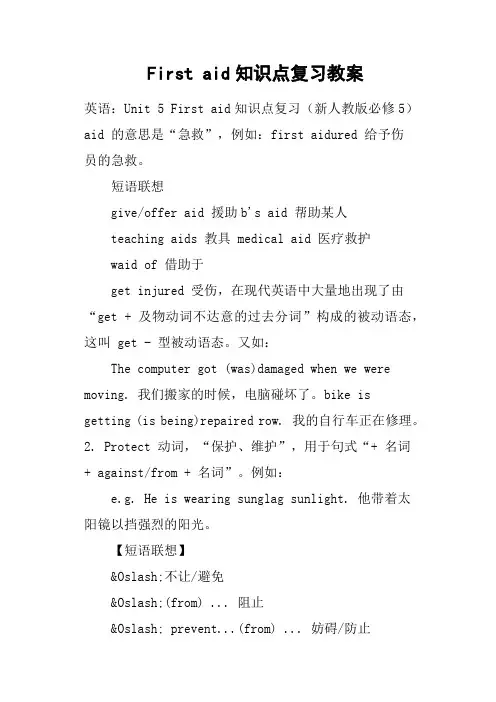
First aid知识点复习教案英语:Unit 5 First aid知识点复习(新人教版必修5)aid 的意思是“急救”,例如:first aidured 给予伤员的急救。
短语联想give/offer aid 援助b's aid 帮助某人teaching aids 教具 medical aid 医疗救护waid of 借助于get injured 受伤,在现代英语中大量地出现了由“get + 及物动词不达意的过去分词”构成的被动语态,这叫 get - 型被动语态。
又如:The computer got (was)damaged when we were moving. 我们搬家的时候,电脑碰坏了。
bike isgetting (is being)repaired row. 我的自行车正在修理。
2. Protect 动词,“保护、维护”,用于句式“+ 名词+ against/from + 名词”。
例如:e.g. He is wearing sunglag sunlight. 他带着太阳镜以挡强烈的阳光。
【短语联想】Ø不让/避免Ø(from) ... 阻止Ø prevent...(from) ... 妨碍/防止Ø disabl使……失去(能力/资格)Ø sav挽救、拯救3.depend on 取决于。
例如:e.g. The amount you pay depends on where you live. 你付多少取决于你住哪里。
词义拓展depend on 依靠,依赖:His family depend他的一家人全靠他养活。
依赖,信任:We are depending on youb by Friday. 我们相信你在星期五前能完成这项工作。
4. squeeze 动词,意思是“榨取”、“挤出”,例如:squeeze an orange 榨橘子常用句式squeeze + 名词 + out(of/from) + 名词,例如:e.g. Those blackmailded to squu那些勒索者打算向他榨取更多的钱。
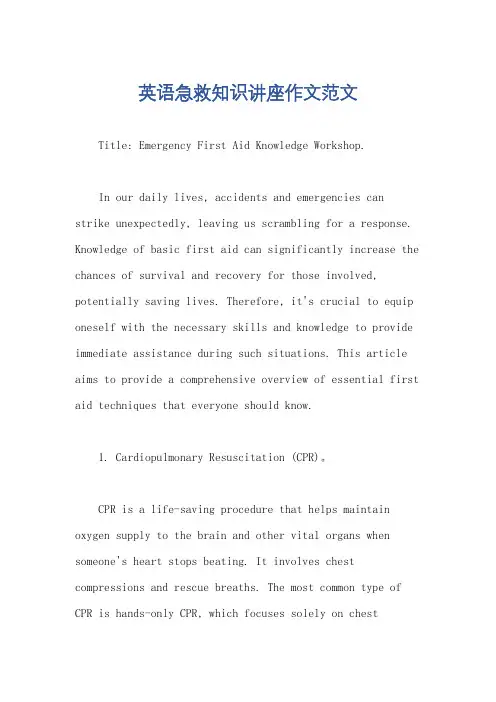
英语急救知识讲座作文范文Title: Emergency First Aid Knowledge Workshop.In our daily lives, accidents and emergencies canstrike unexpectedly, leaving us scrambling for a response. Knowledge of basic first aid can significantly increase the chances of survival and recovery for those involved, potentially saving lives. Therefore, it's crucial to equip oneself with the necessary skills and knowledge to provide immediate assistance during such situations. This article aims to provide a comprehensive overview of essential first aid techniques that everyone should know.1. Cardiopulmonary Resuscitation (CPR)。
CPR is a life-saving procedure that helps maintain oxygen supply to the brain and other vital organs when someone's heart stops beating. It involves chest compressions and rescue breaths. The most common type of CPR is hands-only CPR, which focuses solely on chestcompressions. To perform hands-only CPR, follow these steps:Call 911 or your local emergency services immediately.Check if the victim is unresponsive and not breathing normally.Position yourself above the victim's chest,interlocking your hands and placing the heel of one hand on the center of the chest.Compress the chest at least 100 to 120 times per minute, pressing down about 2 to 2.5 inches (5 to 6 cm).Continue compressions until professional help arrives.2. Bleeding Control.Bleeding is a common occurrence during accidents. It's essential to control bleeding promptly to prevent excessive blood loss. Here are some tips:Apply direct pressure to the wound using a clean cloth or gauze.Elevate the injured part above the heart level if possible.Avoid removing clots that have formed on the wound.If the bleeding doesn't stop after 10 minutes ofdirect pressure, use a tourniquet to control the blood flow. However, ensure you don't apply it tightly around joints or limbs as it can cause permanent damage.3. Burns.Burns can range from minor sunburns to severe thermal, chemical, or electrical burns. Here's how to handle burns:Cool the burned area with running water for at least20 minutes.Avoid applying ointments, lotions, or ice directly tothe burn.Cover the burn with a clean, dry cloth.Seek medical attention immediately for severe burns.4. Broken Bones and Fractures.Fractures are common during falls, accidents, or sports injuries. Handling a broken bone incorrectly can worsen the injury. Here's what to do:Avoid moving the injured area if possible.Immobilize the injury by using splints or makeshift splints (e.g., sticks, boards).Apply a cold compress to reduce swelling and pain.Seek medical attention promptly.5. Choking.Choking is a life-threatening emergency that requires immediate intervention. If someone is choking, follow these steps:Ask the person if they can speak or cough. If they can, encourage them to do so.If the person can't speak or cough, immediatelyperform the Heimlich maneuver. Stand behind the victim,wrap your arms around their waist, and make a fist with one hand. Place the fist just above the navel and pull inward and upward with a rapid upward thrust.If the Heimlich maneuver doesn't work, call 911 oryour local emergency services immediately.In conclusion, knowledge of basic first aid techniques can significantly improve outcomes during emergencies. Everyone should take the initiative to learn these skills, as they could potentially save a life. Remember, in case ofany emergency, always call your local emergency services immediately. Stay safe, stay prepared!。

关于急救知识的简短的英文资料1. 关于“急救学问”的英语作文范例指望可以帮到你,便利你更好的理解,也顺便附上相关的译文,要记得接受哦Frist aidIt is important for you to learn some knowledge about first aid in your daily life. If a person has an accident, he needs medical care before a doctor can befound. When you give first aid, you must pay attention to three things. First, when a person stops breathing, open his/her mouth and see if there is food at the bulk of his/her mouth. Second, if a person cannot breathe, do you best to start his/her breathing急救在日常生活中,学习一些急救学问,对一个人来说很重要。
假如一个人发生车祸,在医生到来之前,需要对他进行医疗护理,做急救时,应留意以下二点。
首先,假如他住手了呼吸,掰开他的嘴巴看看喉咙口有无食物。
其次,假如他不能呼吸,就实行人工呼吸的方法,尽快使他开头呼吸。
再其次,假如他伤的很重,应即将止血,然后送往医院。
假如他失血过多,达三分之一,那末他有可能会死。
很多不测大事也有可能在家里发生。
于是,家长们应把握一些急救常识,以便对付一些发生在孩子身上的大事。
假如孩子被动物咬伤,先用自来水冲洗伤口,然后送去看医生。
假如孩子被烫伤,先用自来水冲洗,降温,然后用一块洁净的干布盖住伤口。
假如烫伤很严峻,应去看医生。
假如割伤了手指,应先将伤口处理洁净,然后用一块纸包扎伤口。
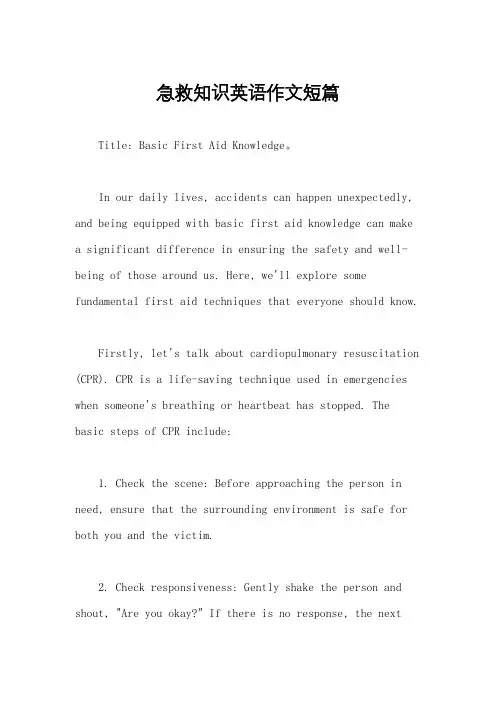
急救知识英语作文短篇Title: Basic First Aid Knowledge。
In our daily lives, accidents can happen unexpectedly, and being equipped with basic first aid knowledge can make a significant difference in ensuring the safety and well-being of those around us. Here, we'll explore some fundamental first aid techniques that everyone should know.Firstly, let's talk about cardiopulmonary resuscitation (CPR). CPR is a life-saving technique used in emergencies when someone's breathing or heartbeat has stopped. The basic steps of CPR include:1. Check the scene: Before approaching the person in need, ensure that the surrounding environment is safe for both you and the victim.2. Check responsiveness: Gently shake the person and shout, "Are you okay?" If there is no response, the nextstep is to...3. Call for help: Dial emergency services immediatelyor instruct someone nearby to do so.4. Open the airway: Tilt the person's head backslightly and lift the chin to open the airway.5. Check for breathing: Place your ear near theperson's mouth and nose to listen and feel for breathing.If the person is not breathing, it's time to begin chest compressions.6. Start chest compressions: Place the heel of one hand on the center of the person's chest (between the nipples) and place the other hand on top. Lock your elbows and use your body weight to push down firmly at least 2 inches deep. Perform chest compressions at a rate of 100-120 per minute.7. Give rescue breaths: If you're trained and comfortable doing so, give rescue breaths after every 30 compressions. Tilt the person's head back, pinch their noseclosed, and give two breaths into their mouth while watching for the chest to rise.Remember, the goal of CPR is to keep oxygenated blood flowing to the vital organs until medical help arrives.Next, let's discuss how to treat common injuries:1. Cuts and wounds: Clean the wound with water and apply pressure to stop bleeding. Cover the wound with a sterile bandage or clean cloth.2. Burns: For minor burns, run cool water over the affected area for several minutes. Do not apply ice or butter. Cover the burn with a sterile gauze or clean cloth.3. Sprains and strains: Rest the injured limb, apply ice (wrapped in a cloth) to reduce swelling, compress the area with a bandage, and elevate the limb above heart level if possible.4. Fractures: If you suspect a fracture, immobilize theinjured limb using a splint or improvised materials (such as a rolled-up magazine or cardboard). Seek medical help immediately.Lastly, it's crucial to remain calm and composed in emergency situations. Panicking can hinder your ability to provide effective assistance. Remember to assess the situation, prioritize the most critical needs, and take action accordingly.By familiarizing yourself with these basic first aid techniques, you can become a valuable asset in any emergency situation. Always remember that prompt action can save lives.。
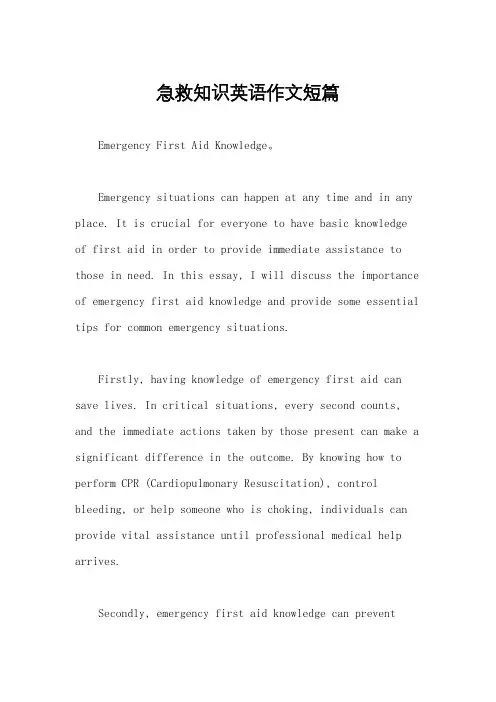
急救知识英语作文短篇Emergency First Aid Knowledge。
Emergency situations can happen at any time and in any place. It is crucial for everyone to have basic knowledge of first aid in order to provide immediate assistance to those in need. In this essay, I will discuss the importance of emergency first aid knowledge and provide some essential tips for common emergency situations.Firstly, having knowledge of emergency first aid can save lives. In critical situations, every second counts, and the immediate actions taken by those present can make a significant difference in the outcome. By knowing how to perform CPR (Cardiopulmonary Resuscitation), control bleeding, or help someone who is choking, individuals can provide vital assistance until professional medical help arrives.Secondly, emergency first aid knowledge can preventfurther injuries or complications. For example, in the case of a bone fracture, knowing how to immobilize the injured limb can prevent further damage. Similarly, understanding how to properly dress a wound can reduce the risk of infection. By having this knowledge, individuals can help stabilize the condition of the injured person and minimize the potential for additional harm.Furthermore, emergency first aid knowledge increases personal confidence and the ability to take action in emergency situations. Many people feel helpless or overwhelmed when faced with an emergency, but having the necessary skills and knowledge can empower individuals to take control of the situation. This confidence can be a crucial factor in providing effective aid to those in need.Now, let's delve into some essential tips for common emergency situations:1. Cardiopulmonary Resuscitation (CPR): CPR is a life-saving technique that can be performed on individuals who have stopped breathing or whose heart has stopped beating.To perform CPR, first, check if the person is responsive and breathing. If not, call for help and start chest compressions. Place the heel of one hand on the center of the person's chest, and interlock the other hand on top. Push hard and fast, aiming for a rate of 100-120 compressions per minute, until professional help arrives.2. Choking: If someone is choking and unable to breathe or speak, immediate action is required. Stand behind the person and wrap your arms around their waist. Make a fist with one hand and place it just above the person's navel, thumb side in. Grasp the fist with your other hand and give quick upward thrusts until the object blocking the airwayis dislodged.3. Bleeding: In the case of severe bleeding, apply direct pressure to the wound using a clean cloth or your hand. Elevate the injured area if possible, and maintain pressure until help arrives.4. Burns: For minor burns, cool the affected area under running water for at least 10 minutes. Avoid using ice orvery cold water, as it can further damage the skin. Cover the burn with a sterile dressing or non-stick bandage. Seek medical attention for more severe burns.5. Fractures: If you suspect someone has a broken bone, encourage them to remain still and support the injured area. If necessary, immobilize the limb using a splint or makeshift support, such as rolled-up newspapers or cardboard.Remember, these tips are just a starting point, and itis highly recommended to attend a first aid training course to gain comprehensive knowledge and practical skills in emergency situations.In conclusion, having knowledge of emergency first aidis essential for everyone. It can save lives, preventfurther injuries, and increase personal confidence. By understanding and applying basic first aid techniques, individuals can make a significant difference in emergency situations. So, let's equip ourselves with this valuableknowledge and be prepared to lend a helping hand when needed.。
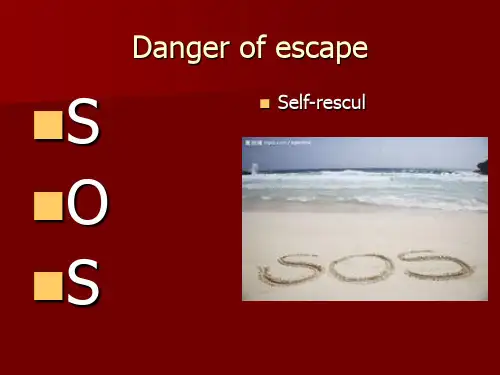
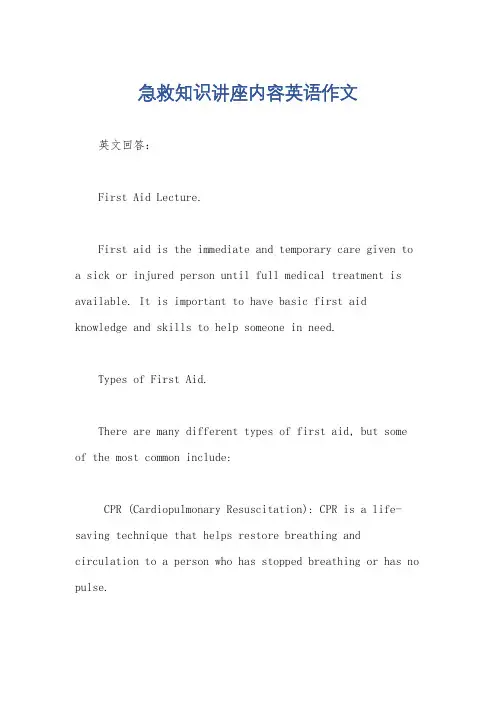
急救知识讲座内容英语作文英文回答:First Aid Lecture.First aid is the immediate and temporary care given to a sick or injured person until full medical treatment is available. It is important to have basic first aid knowledge and skills to help someone in need.Types of First Aid.There are many different types of first aid, but some of the most common include:CPR (Cardiopulmonary Resuscitation): CPR is a life-saving technique that helps restore breathing and circulation to a person who has stopped breathing or has no pulse.First aid for bleeding: Bleeding can be stopped by applying pressure to the wound and elevating the injured limb.First aid for burns: Burns can be treated by coolingthe burn with water and covering it with a sterile dressing.First aid for fractures: Fractures can be treated by immobilizing the injured limb and applying a splint.First aid for sprains and strains: Sprains and strains can be treated by applying ice to the injured area and resting it.How to Perform First Aid.If you come across someone who needs first aid, it is important to assess the situation and determine the type of injury. Once you know what type of injury you are dealing with, you can follow these steps to perform first aid:1. Stay calm and assess the situation.2. Call for emergency medical help if necessary.3. Make the person comfortable and safe.4. Treat the injury according to the type of injury.5. Stay with the person until medical help arrives.Importance of First Aid.First aid is important because it can help save lives and prevent further injury. By knowing how to perform basic first aid, you can be prepared to help someone in need inan emergency situation.中文回答:急救知识讲座。

面试英语急救知识题目大全1. 介绍面试英语急救知识题目旨在考察应聘者在应急情况下的英语交流能力和专业知识。
以下是一些常见的面试英语急救知识题目,希望能对应聘者在面试中有所帮助。
2. 题目示例2.1. 问句回答1.How would you ask someone if they are okay?2.What should you do if someone is bleeding?3.How would you ask someone if they have any allergies?4.What are the steps you would take if you suspect someone is having aheart attack?5.How would you ask someone if they are feeling dizzy?6.What should you do if someone is unconscious but breathing?7.How would you ask someone if they have any medical conditions?8.How would you ask someone if they are choking?9.What should you do if someone is experiencing a seizure?10.How would you ask someone if they have any medications they arecurrently taking?2.2. 句子补全1.If someone has a severe burn, you should _______________.2.When performing CPR on an adult, you should _______________.3.If a person is conscious but cannot speak, you should _______________.4.When applying a bandage to a wound, you should _______________.5.If someone is experiencing severe chest pain, you should _______________.6.If a person is choking and unable to breathe, you should _______________.7.When assessing a person’s vital signs, you should _______________.8.If a person is having a seizure, you should _______________.9.When dealing with a head injury, you should _______________.10.If someone is showing signs of an allergic reaction, you should_______________.2.3. 简答题1.What is the importance of CPR in emergency situations?2.How would you approach a conscious but agitated patient?3.What are the signs of a stroke and how would you respond?4.How can you determine if someone is experiencing an allergic reaction?5.What are the steps you would take if someone is unconscious and not breathing?6.How would you assess the severity of a burn?7.What are the signs of a heart attack and how would you respond?8.What is the purpose of the recovery position and when should it be used?9.How would you respond to someone who is experiencing an asthma attack?10.What are the steps you would take if someone is choking and unable to breathe?3. 题目解答3.1. 问句回答1.“Are you okay?”2.“What happened? Let me stop the bleeding.”3.“Do you have any allergies?”1)Call emergency services. 2) Have the person sit down and rest.3) Loosen any tight clothing. 4) Assist with their prescribed medicationif they have any.4.“Are you feeling dizzy?”1)Check for responsiveness. 2) Call emergency services. 3) If theperson is breathing, turn them onto their side in a recovery position.5.“Do you have any medical conditions?”6.“Are you choking?”1)Ensure the person is in a safe place. 2) Clear the area aroundthem. 3) Do not restrain the person. 4) After the seizure, have the person rest and monitor their condition.7.“Are you currently taking any medications?”3.2. 句子补全1.If someone has a severe burn, you should remove the person from the source of the burn and cool the affected area with cool running water.2.When performing CPR on an adult, you should place the heel of one hand on the center of the person’s chest and interl ock your other hand on top. Perform chest compressions at a rate of 100 to 120 compressions per minute.3.If a person is conscious but cannot speak, you should ask them to blink or nod their head to indicate “yes” or “no” answers.4.When applying a bandage to a wound, you should first clean the wound with soap and water, cover it with a sterile dressing, and secure the dressing in place with adhesive tape or a bandage.5.If someone is experiencing severe chest pain, you should call emergency services immediately and have the person rest in a comfortable position.6.If a person is choking and unable to breathe, you should stand behind them and give abdominal thrusts (also known as the Heimlich maneuver) until the object blocking the airway is dislodged.7.When assessin g a person’s vital signs, you should check their pulse, respiratory rate, blood pressure, and temperature.8.If a person is having a seizure, you should clear the area around them of any potential hazards, protect their head from injury, and time the duration of the seizure.9.When dealing with a head injury, you should apply direct pressure to any bleeding wounds, keep the person still and elevate their head if there is no suspected neck injury.10.If someone is showing signs of an allergic reaction, you should call emergency services and help the person take their prescribed medication (such as an epinephrine auto-injector) if they have one.3.3. 简答题1.CPR is important in emergency situations as it helps maintain blood flow and oxygenation to vital organs when a pe rson’s heart has stopped beating. It can buy time until professional medical help arrives.2.When approaching a conscious but agitated patient, it is important to remain calm, speak in a reassuring tone, and maintain a safe distance. Avoid sudden movements and try to understand their concerns or needs.3.Signs of a stroke include sudden weakness or numbness on one side of the body, confusion, difficulty speaking or understanding speech, trouble seeing, dizziness, and severe headache. If someone is showing signs of a stroke, it is important to call emergency services immediately.4.An allergic reaction can manifest as skin rash, swelling, itching, difficulty breathing, or gastrointestinal symptoms. The presence of hives or swelling, particularly around the face and throat, can indicate a severe allergic reaction known as anaphylaxis.5.If someone is unconscious and not breathing, it is important to call emergency services immediately and start CPR. Begin with chest compressions followed by rescue breaths until professional help arrives.6.The severity of a burn can be assessed based on the depth and extent of the burn. First-degree burns affect the outer layer of skin and are characterized by redness and pain. Second-degree burns involve the outer and underlying layers of skin, causing blistering and intense pain. Third-degree burns penetrate all layers of the skin, resulting in charring or white, blackened skin.7.Signs of a heart attack include chest pain or discomfort, shortness of breath, nausea or vomiting, lightheadedness, and pain or discomfort in thearms, back, neck, jaw, or stomach. If someone is showing signs of a heart attack, it is important to call emergency services immediately.8.The recovery position is a way of placing an unconscious butbreathing person on their side to maintain an open airway and prevent choking.It should be used when the person is not injured and there is no suspicion of a neck or spinal injury.9.When someone is experiencing an asthma attack, it is important tohelp them sit upright and assist them in using their prescribed inhaler. If thesymptoms worsen or the person does not have an inhaler, emergency services should be called.10.If someone is choking and unable to breathe, the Heimlich maneuvershould be performed. Stand behind the person, place your fist above their navel, and grasp your fist with your other hand. Give quick upward thrusts until the object blocking the airway is dislodged.以上是一些常见的面试英语急救知识题目及其解答。


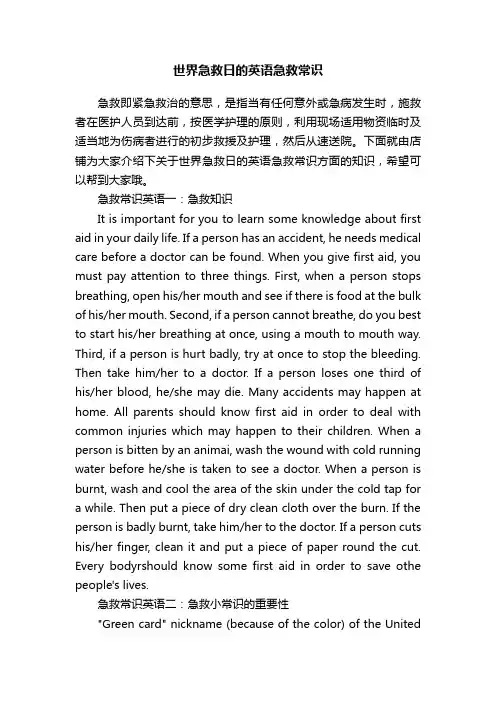
世界急救日的英语急救常识急救即紧急救治的意思,是指当有任何意外或急病发生时,施救者在医护人员到达前,按医学护理的原则,利用现场适用物资临时及适当地为伤病者进行的初步救援及护理,然后从速送院。
下面就由店铺为大家介绍下关于世界急救日的英语急救常识方面的知识,希望可以帮到大家哦。
急救常识英语一:急救知识It is important for you to learn some knowledge about first aid in your daily life. If a person has an accident, he needs medical care before a doctor can be found. When you give first aid, you must pay attention to three things. First, when a person stops breathing, open his/her mouth and see if there is food at the bulk of his/her mouth. Second, if a person cannot breathe, do you best to start his/her breathing at once, using a mouth to mouth way. Third, if a person is hurt badly, try at once to stop the bleeding. Then take him/her to a doctor. If a person loses one third of his/her blood, he/she may die. Many accidents may happen at home. All parents should know first aid in order to deal with common injuries which may happen to their children. When a person is bitten by an animai, wash the wound with cold running water before he/she is taken to see a doctor. When a person is burnt, wash and cool the area of the skin under the cold tap for a while. Then put a piece of dry clean cloth over the burn. If the person is badly burnt, take him/her to the doctor. If a person cuts his/her finger, clean it and put a piece of paper round the cut. Every bodyrshould know some first aid in order to save othe people's lives.急救常识英语二:急救小常识的重要性"Green card" nickname (because of the color) of the UnitedStates Permanent Resident Card,an identification document issued by the United States of America affording non-citizens of that country some of the rights its citizens enjoy,sometimes with the prospect of naturalization. A United States Permanent Resident Card,also known as a green card,is an identification card attesting to the permanent resident status of an alien in the United States of America.Green card also refers to an immigration process of becoming a permanent resident.The green card serves as proof that its holder,a Lawful Permanent Resident (LPR),has been officially granted immigration benefits,which include permission to reside and take employment in the USA.The holder must maintain permanent resident status,and can be removed from the US if certain conditions of this status are not met. Green cards were formerly issued by the Immigration and Naturalization Service (INS).That agency has been absorbed into and replaced by the Bureau of Citizenship and Immigration Services (BCIS),part of the Department of Homeland Security (DHS).Shortly after re-organization BCIS was renamed to U.S.Citizenship and Immigration Services急救常识英语三:急救知识My name is li hua, and the most impressive thing of my life came to my life yesterday. When I walked near by a lake with my friend, he was falling into the lake, and I was so worried. I did't know how to swim, but I had to save my friend's live. I was shouting and asking someone to help. After that, the most impressive thing happened which was a young solder that jump into the lake without thinking, swimmed to the palace where my friend were, and got him out of the lake. After the young solder checked if there was nothing wrong with my friend, he went away. In conclusion, this young solder is the one who i respect a lot!急救常识英语四:溺水急救常识If someone becomes the victim of a near-drowning , this fast-action rescue plan can prevent a tragedy. Your first priority is to get the drowning person out of the water as quickly as possible. If he isn't breathing, place him on his back on a firm surface. Immediately begin rescue breathing , and have someone call for help at the same time.. Don't assume it's too late to save a someone's life -- even if he's unresponsive, continue performing CPRcardiopulmonary resuscitation and do not stop until medical professionals take over.。
英语急救知识讲座作文范文First Aid: A Vital Skill for Emergency Situations.In the face of an emergency, having basic first aid knowledge can make all the difference between saving a life or exacerbating the situation. This article aims to provide a comprehensive overview of first aid techniques, equipping you with essential knowledge to respond effectively to common injuries and medical emergencies.1. Assessing the Situation.Before rendering aid, it's crucial to assess the situation and ensure your safety. Approach the scene cautiously, observe the surroundings for potential hazards, and check for responsiveness of the victim. If the victimis unresponsive or in immediate danger, call for professional medical help (911 or your local emergency number) immediately.2. Basic Wound Care.Wounds are a common occurrence in various emergencies. To properly treat a wound, follow these steps:Control bleeding: Apply direct pressure to the wound using a clean cloth or gauze until the bleeding stops.Clean the wound: Use soap and water or an antiseptic solution to clean the wound and remove any dirt or debris.Bandage the wound: Protect the wound from further contamination by covering it with a sterile bandage. Secure the bandage to prevent slippage.3. Fracture Management.A fracture is a break in a bone. If you suspect a fracture:Immobilize the injured area: Use a splint or support to prevent movement and further injury.Apply ice: Wrap an ice pack in a cloth and apply it to the injured area to reduce swelling and pain.Seek professional help: A healthcare professional will need to assess the injury and determine the best course of treatment.4. Burns.Burns can be caused by fire, heat, or chemicals. For minor burns:Cool the burn: Run cold water over the burn for at least 10 minutes or apply a cold compress. Do not use ice directly on the burn.Cover the burn: Apply a loose, sterile bandage to protect the burn from infection.Seek medical attention: Seek professional help if the burn is large, deep, or causes blistering.5. Sprains and Strains.Sprains and strains are injuries to ligaments and muscles, respectively. To manage these injuries:Rest the injured area: Avoid using the injured limb or muscle to prevent further strain.Apply ice: As with fractures, ice can help reduce swelling and pain.Compress the area: Wrap an elastic bandage around the injured area to provide support and reduce swelling.6. Shock.Shock is a life-threatening condition that occurs when the body is unable to get enough blood flow to its cells. Signs of shock include pale skin, rapid pulse, shallow breathing, and confusion. To manage shock:Lay the victim down: Position the victim with their legs elevated to promote blood flow to the brain.Cover the victim: Keep the victim warm with a blanketor coat.Seek professional help: Shock requires immediate medical attention. Call for an ambulance immediately.7. CPR and AED Usage.Cardiac arrest is a sudden loss of heart function. If you encounter someone who is not breathing and has no pulse, perform CPR (cardiopulmonary resuscitation) immediately. If an automated external defibrillator (AED) is available, use it according to its instructions.8. Common Medical Emergencies.Apart from injuries, there are other common medical emergencies that require prompt attention, including:Heart attack: Symptoms include chest pain, shortnessof breath, and pain radiating to the left arm, jaw, or back.Stroke: Symptoms include sudden weakness or numbnessin the face, arm, or leg, confusion, speech difficulties, and loss of balance.Seizure: Symptoms include violent shaking, loss of consciousness, and involuntary bowel or bladder movements.9. Additional Tips.Stay calm and reassure the victim: Keep the victimcalm and provide them with reassurance that help is on the way.Protect yourself: Wear gloves when handling blood or bodily fluids to prevent infection.Seek professional help when necessary: If the injuryor condition is severe or you are unsure of how to proceed, do not hesitate to seek professional medical assistance.Conclusion.First aid is an essential skill that empowers individuals to provide life-saving assistance in emergency situations. By equipping yourself with the knowledge and techniques outlined in this article, you can make a significant difference in preserving lives and preventing further injury. Remember to practice these techniques regularly and stay updated on current first aid guidelines to ensure your knowledge is up-to-date.。
帮我写一篇向外国人介绍急救知识的英语作文Title: Introduction to First Aid KnowledgeFirst aid is the immediate care given to a person who has been injured or taken ill before the arrival of professional medical assistance. It is crucial to have some basic knowledge of first aid in order to provide immediate help to those in need. In this article, we will introduce some essential first aid techniques that everyone should know.1. Cardiopulmonary Resuscitation (CPR): CPR is a life-saving technique that is used in emergencies such as cardiac arrest or drowning. It involves chest compressions and rescue breaths to help maintain blood flow to the vital organs until professional help arrives. Remember the acronym CAB – Compression, Airway, Breathing – when performing CPR.2. Bleeding: If someone is bleeding, it is important to control the bleeding as quickly as possible. Apply pressure to the wound with a clean cloth or bandage and elevate the injured area if possible. Do not remove any objects that are stuck in the wound as this could make the bleeding worse.3. Burns: For minor burns, run the affected area under cool water for at least 10 minutes to help alleviate pain and reduceswelling. Do not use ice or butter on a burn as this can further damage the skin. For more severe burns, seek professional medical help immediately.4. Choking: If someone is choking, encourage them to cough forcefully. If the person is unable to breathe or talk, perform the Heimlich maneuver by giving abdominal thrusts until the object is dislodged. If the person becomes unconscious, perform CPR.5. Sprains and Strains: For minor sprains and strains, remember RICE – Rest, Ice, Compression, Elevation. Rest the injured area, apply ice to reduce swelling, wrap the area with a compression bandage, and elevate the injured limb. Seek medical attention if the pain persists.These are just a few basic first aid techniques that everyone should know. Remember, it is important to stay calm and assess the situation before providing aid. Knowing how to properly administer first aid could potentially save someone's life. Take a first aid course in your community to learn more about how to respond in emergencies.。
急救知识的英语作文First Aid Knowledge。
Accidents can happen at any time and in any place, and it's important for everyone to have a basic understanding of first aid. First aid is the initial care given to a sick or injured person before professional medical help arrives. It can make a huge difference in the outcome of an emergency situation, and having the knowledge and skills to administer first aid can save lives.One of the most important aspects of first aid is knowing how to assess the situation and respond appropriately. This includes being able to recognize the signs and symptoms of different medical emergencies, such as heart attacks, strokes, and allergic reactions. It's also important to know how to provide basic care for injuries such as cuts, burns, and fractures.In addition to knowing how to assess and respond todifferent emergencies, it's also important to have theskills to administer first aid. This includes knowing howto perform CPR, use an automated external defibrillator (AED), and apply bandages and splints. These skills can be crucial in saving someone's life in an emergency situation.Another important aspect of first aid is knowing how to prevent further injury or harm. This includes knowing howto move an injured person safely, how to control bleeding, and how to provide comfort and reassurance to someone whois sick or injured. It's also important to know when toseek professional medical help and how to communicate effectively with emergency medical services.Having a good understanding of first aid can also helpto build confidence and reduce fear in emergency situations. When people know what to do in an emergency, they are more likely to take action and provide help when it's needed. This can make a huge difference in the outcome of an emergency situation and can help to save lives.In conclusion, first aid knowledge is a crucial skillthat everyone should have. It can make a huge difference in the outcome of an emergency situation and can help to save lives. By knowing how to assess and respond to different emergencies, having the skills to administer first aid, and knowing how to prevent further injury or harm, people can be better prepared to handle medical emergencies and provide help when it's needed. It's important for everyone to take the time to learn first aid and be prepared to act in an emergency.。
急救知识英语作文First Aid Knowledge。
Accidents can happen at any time and in any place, and it is important for everyone to have a basic understanding of first aid. First aid is the initial assistance or treatment given to someone who is injured or suddenly taken ill before the arrival of professional medical help. It can make a significant difference in the outcome of an emergency situation, so having the knowledge and skills to provide first aid can be life-saving.One of the most important aspects of first aid is knowing how to assess the situation and respond appropriately. This includes checking for any immediate dangers to yourself and the injured person, as well as identifying the nature and severity of the injury or illness. It is crucial to remain calm and focused in order to provide effective assistance.Another key aspect of first aid is knowing how to administer basic medical treatment. This can include providing CPR to someone who is not breathing, applying pressure to a wound to stop bleeding, or immobilizing a broken bone. These skills can help to stabilize the injured person and prevent their condition from worsening while waiting for professional medical help to arrive.In addition to these practical skills, having a good understanding of first aid principles is also important. This includes knowing how to prioritize treatment for multiple injuries, recognizing the signs of common medical emergencies such as heart attacks or strokes, and understanding when it is necessary to seek further medical assistance.It is also important to be prepared for emergencies by having a first aid kit readily available. A well-stocked first aid kit should contain items such as bandages, adhesive tape, antiseptic wipes, scissors, tweezers, and gloves. Having these supplies on hand can make it easier to provide effective first aid in an emergency situation.In conclusion, having a basic understanding of first aid is essential for everyone. Whether it is a minor injury at home or a more serious emergency in a public setting, knowing how to assess a situation, administer basic medical treatment, and respond appropriately can make a significant difference in the outcome. By learning and practicing first aid skills, individuals can be better prepared to help others in need and potentially save lives.。
校园急救小知识英语作文英文:As a student, it's important to have some basic knowledge of first aid in case of emergencies on campus. Here are some small tips that could be helpful:1. If someone is bleeding, apply pressure to the wound with a clean cloth or bandage to stop the bleeding.2. If someone is unconscious, check their airway, breathing, and pulse. If necessary, perform CPR.3. If someone is choking, perform the Heimlich maneuver to help them dislodge the object from their airway.4. If someone is having a seizure, move any nearby objects out of the way and gently guide the person to the ground to prevent injury.It's also important to know where the nearest first aid kit and AED (automated external defibrillator) are located on campus. These can be lifesaving in an emergency situation.中文:作为一名学生,在校园发生紧急情况时,具备一些基本的急救知识是非常重要的。
初一英语急救知识单选题50题1. In a park, a boy suddenly fainted. People around knew they should give him ____ first.A. some waterB. first aidC. a toyD. a phone call答案:B。
解析:本题考查急救的基本概念。
在有人突然晕倒的情况下,首先应该给予的是急救,而不是一些水(A选项,在未确定病因时不能随意喂水),也不是一个玩具 C选项与急救毫无关系),虽然可能之后会打急救电话,但首先要做的是急救而不是直接打个电话 D选项)。
2. The purpose of first aid is to ____.A. make the patient very comfortableB. replace the doctor's treatmentC. save lives and prevent the condition from getting worseD. make the patient look good答案:C。
解析:急救的目的是挽救生命并且防止状况恶化。
A选项让病人非常舒服不是急救的主要目的;B选项急救不能替代医生的治疗;D选项让病人看起来好也不是急救的目的。
3. When we talk about first aid, it is mainly for ____.A. healthy peopleB. people in danger or suddenly illC. old people onlyD. children only答案:B。
解析:急救主要是针对处于危险中或者突然生病的人。
A选项健康人不需要急救;C选项急救不只是针对老人;D选项也不只是针对儿童。
4. A man got a cut on his finger while cooking. First aid at this time is to ____.A. cover the cut with a dirty clothB. let it bleed freelyC. clean the cut and put on a clean band - aidD. pour some hot water on it答案:C。